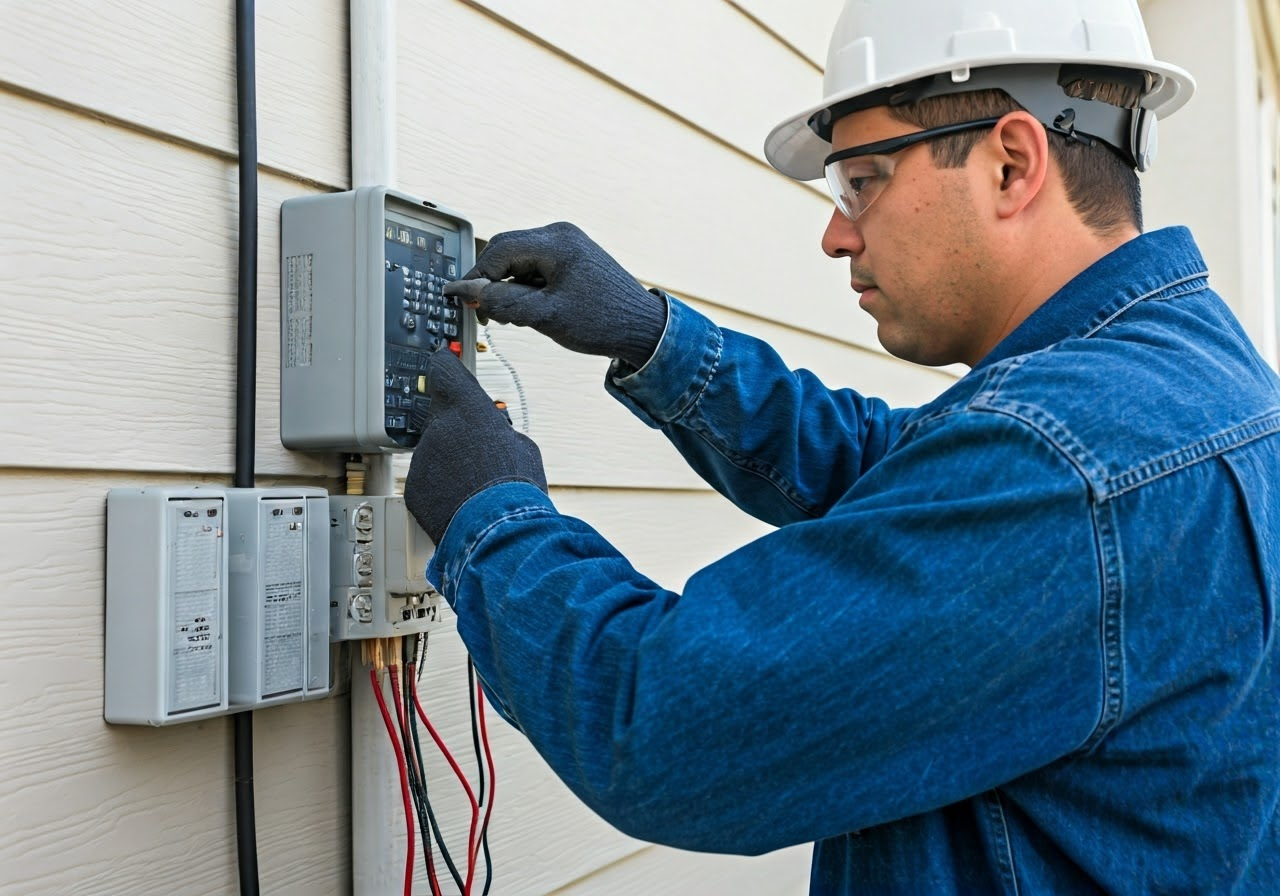The presentation was set, clients were seated, and the projector refused to turn on. Despite full power to the building, nothing worked. Embarrassed, Victor, the business manager, scrambled for a fix.
The issue wasn’t a power failure. It was a low-voltage wiring issue behind the scenes. He quickly called a low-voltage electrician. These experts fix the complex network of communication and control wiring that standard electricians may not be able to fix.
This includes AV systems and internet cables. Low-voltage electricians help in keeping business operations running smoothly. Join us as we show you what these professionals do and why you may need them.
Are you ready? Let’s get started!
Key Highlights
- Low-voltage electricians are a special group of electrical professionals. They usually deal with electrical wiring for systems that require lower power consumption and efficiency.
- Hiring a low-voltage electrician with years of experience is important for any home or business.
Understanding the Role of a Low-Voltage Electrician
Low-voltage electricians work with systems that are lower than the standard voltage operating range. These are voltages under 50V AC or 120V DC.
Their responsibilities usually revolve around ensuring the safe and efficient operation of security systems. This also includes communication systems and audio wiring.
These professionals also give their customers peace of mind by integrating complex setups with precision. Their work has become very important.
Many new homes and businesses use smart technologies. This includes techs like IoT-connected thermostats and advanced surveillance systems. Hiring a low-voltage electrician is a good choice, as they can make your transition to these innovations easy.
Definition and responsibilities
Low-voltage electricians are a special group of electrical professionals. They usually deal with electrical wiring for systems that require lower power consumption and efficiency. These include alarm systems, CCTV installations, structured cabling, and smart home setups.
They specialize in reduced voltage. These experts also ensure proper installation. They follow the industry guidelines to mitigate electrical hazards.
That’s not all. Their responsibilities are more than simple wiring. They combine multiple systems when fixing signal loss and shorting issues to maintain the effective operation of your electrical devices.
For example, they can install a wireless router in a home. This will require careful attention to volts, signal strength, and connectivity. The truth? These special electricians help their customers to maintain a safe, low-voltage system.
These professionals enable organizations to prepare themselves for future developments in security systems and lighting fixtures. This also includes IoT technology devices.
These specialists maintain electrical systems through modern solutions, which makes them important for our modern world.
Typical day-to-day tasks
Low-voltage electricians typically start their day by reviewing projects. This includes fixing security systems or configuring telecommunication systems.
For example, installing a surveillance camera involves checking data connections. This process helps to ensure power continuity and removes blind spots.
Later, they may move to fixing lighting systems to deliver energy-efficient lighting solutions for interiors or outdoor spaces. These professionals perform tasks such as arranging fixtures, selecting proper wattages, and configuring timers.
This reveals their job experience and how much they pay attention to detail. The modern need for reduced power consumption makes their expertise vital.
That’s not all. By afternoon, their work could involve troubleshooting or upgrading systems like Wi-Fi routers and local area networks. They will ensure connectivity and proper cabling. This enables the smooth operation across devices.
With increasing reliance on smart home technology, their adaptability is important. A normal day for them is all about customer satisfaction and keeping up with evolving electrical needs.
Key Areas of Expertise for Low-Voltage Technicians

Low-voltage electricians cater to important areas. They help businesses and homeowners use smart systems the right way. Their expertise focuses on security systems and communication systems.
That’s not all. They can also install lighting systems in buildings. From surveillance systems to smart home automation, these experts maintain smooth operations through structured installations and optimized designs.
They also work on energy-efficient systems. This includes landscape lighting and fixtures that lower utility bills and improve the aesthetics of your building. Hiring an experienced low-voltage electrician is very important.
A professional will ensure the safety of their clients. They will also do their job in accordance with the electrical standards to give you long-term system reliability.
Security systems installation and maintenance
Security systems, including CCTV cameras and surveillance systems, form a major part of a low-voltage electrician’s repertoire. They handle installations to ensure homeowners and organizations receive easy monitoring and protection. These system tasks include:
- Placing cameras in the right position for better coverage.
- Configuring fire alarms and motion detectors to help prevent false alarms.
- Following the industry standards for electrical wiring.
The proper maintenance of these systems usually requires inspecting breakpoints. It also includes adjusting camera angles or integrating backup circuits. A low-voltage electrician ensures smooth operation, they also address important issues like data loss.
Hiring a low-voltage electrician with years of experience is important for any home or business. These specialists possess the skills to secure homes against intrusions. This makes them valuable for creating a reliable security system that works without interruption.
Telecommunication systems setup
Telecommunication systems are very important for modern homes and offices. This includes local area networks and larger internet connectivity. Low-voltage electricians help in creating proper setups for structured wiring and smooth integration.
These professionals will start by installing important components. This includes Wi-Fi routers or Ethernet outlets for proper connectivity across spaces. They also fix outdated system issues.
An expert will help you upgrade to high-quality cabling options like Cat6 or fiber optic cables for speed and reliability.
That’s not all. These electricians know the right installation process that will withstand interference from environmental factors. And guess what? They can also help you prevent virtual meeting connection issues.
Their skills transform everyday communication systems into high-functioning networks tailored for individuals and enterprises alike.
Essential Tools and Equipment Used by Low-Voltage Electricians
Low-voltage electricians depend on some necessary electrical tools. This ranges from electrical instruments to cabling accessories. Some important equipment also includes voltage testers, wire cutters, and pliers. This helps to guarantee wiring precision and safety.
That’s not all. Technologies like transformers and advanced sensors are also important. They help in calibrating the system and fault detection.
Using the right tools makes the installation process easy. It also saves clients from long-term application issues. Their toolkit helps them to address challenges properly, promoting secure systems.
Specialized electrical instruments
Electrical instruments tailored for precision are necessary for low-voltage electricians. Tools like voltage testers, multimeters, and amp clamps make their work easier. They are used to measure currents and keep the circuit safe.
These tools are very important, especially in environments where instability could lead to faults across devices.
The sensor is another important tool. It is valuable for detecting issues within security systems or motion-sensitive setups. That’s not all. The transformers help regulate voltage levels. They make sure that everything is working well across the interconnected devices.
Technical skills and the right tools help electricians to do their job properly. It also makes sure that installations meet the industry standards. This safeguards home and business infrastructure.
Commonly used low-voltage cables and components
Low-voltage electricians work with many cabling materials for multiple applications. Common examples include Cat6 cables for internet systems.
They also use coaxial cables for television setups and power cords. Their skills ensure proper routing with reduced interference. Here’s a table showing some popular components:
| Component | Purpose | Voltage Range |
| Cat6/Cat6a Cabling | High data speed and audio transfer | ≤50 volts |
| Fiber Optic Cables | Internet data solutions | ≤12 volts |
| RG-6 Coaxial Cable | Satellite signals | ≤30 volts |
These electricians use high-quality structured cabling systems. This guarantees smooth connectivity and complies with the legal guidelines. The result? A safer and more efficient electrical setup.
We Can Help!
Low-voltage systems can be complex and require a thorough understanding. Homeowners should hire reputable electricians. Getting recommendations from your neighbors or friends is a good way to start. However, check their certifications.
A reputable electrician like Frontline Pro Services will have all the necessary certificates. This will give you peace of mind. They will use their experience and tools to give you quality services.
Here in California, Frontline Pro Services is the right low-voltage electrician for you. We have professionals who have soft skills. They also have all the necessary certifications and training programs for maintaining safe and quality repairs.
That’s not all. Our services are fast, efficient, and affordable. Reach out to us now!
Frequently Asked Questions
What qualifies as low voltage in California?
In California, low voltage typically refers to electrical systems operating at less than 50 volts for AC or 120V DC. State regulations require adherence to safety when installing systems.
This includes security cameras or alarm systems to ensure proper handling of electrical power components.


